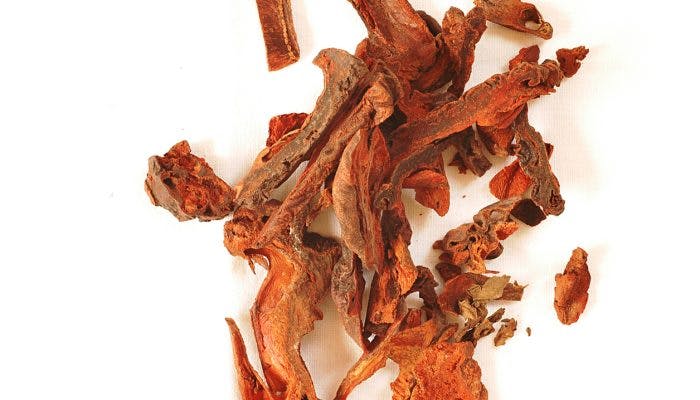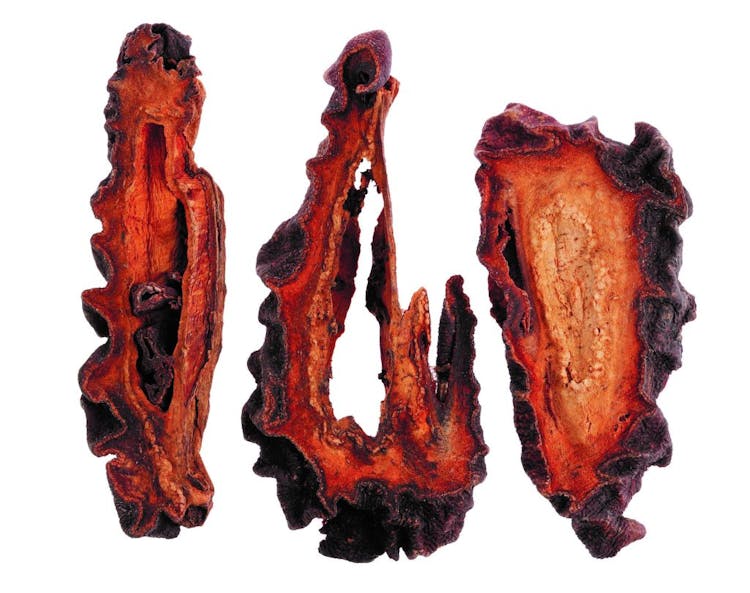Common Flowering Quince Fruit (Mu Gua)

What is Common Flowering Quince Fruit (Mu Gua)?
Common Flowering Quince Fruit (mu gua, 木瓜), also known as Fructus Chaenomelis, is the nearly mature fruit of Chaenomeles speciosa, a deciduous shrub belonging to the family Rosacea. A medicinal and edible plant, Chaenomeles speciosa is light-loving, shade-tolerant and cold-tolerant.
In China, Chaenomeles speciosa is distributed in various regions, such as Sichuan, Hubei, Shandong, Anhui and Zhejiang. Chaenomeles speciosa thrives in rich, well-drained loam soil. In particular, Common Flowering Quince Fruit from Xuancheng City, Anhui, is very famous. Known as Xuan Mu Gua, this type of Common Flowering Quince Fruit has high medicinal value and rich nutrition, and was often used as tribute in the feudal dynasties during ancient times.
First appearing in Supplementary Records of Famous Physicians (Ming Yi Bie Lu, 名医别录) during 420 – 589 AD, Common Flowering Quince Fruit is usually collected during summer and autumn. After the removal of impurities, the fruit is scalded in boiling water to turn the outer skin gray-white in colour, cut and dried under the sun for medicinal usage.
In Traditional Chinese Medicine (TCM), Common Flowering Quince Fruit falls under the category of ‘Herbs that dispel Wind and Dampness’. Such herbs can treat ‘bi (痹) pain’, such as arthritic and rheumatic conditions with pain, stiffness and numbness of bones, joints and muscles.
Warm in nature, Common Flowering Quince Fruit can help individuals with too much Cold in their body, such as those experiencing a Yin Excess or a Yang Deficiency, to restore a harmonious yin-yang balance in the body. Sour in taste, Common Flowering Quince Fruit can aid digestion and restrain abnormal discharges of fluids from the body, such as diarrhoea and heavy sweating. In particular, the herb targets the Liver and the Spleen.
Functions and Benefits of Common Flowering Quince Fruit (Mu Gua)
Traditional Chinese Medicine (TCM) shows that Common Flowering Quince Fruit has the following health benefits.
Common Flowering Quince Fruit can dispel Wind-Damp and activate collaterals. Specialised in the removal of Dampness, Common Flowering Quince Fruit is said to be an essential herb in the treatment of arthralgia caused by Dampness, characterised by spasms of tendons and vessels. This herb can soothe tendons and vessels to relieve such symptoms. Also, Common Flowering Quince Fruit is commonly indicated for aching pain with heavy sensation in the waist, knees and joints. For stiffness in the neck with difficulty in moving it, you can combine Common Flowering Quince Fruit with blood-activating herbs to enhance its effectiveness in treating it too.
Common Flowering Quince Fruit can remove Dampness and relax tendons, which makes it an effective treatment for the downward flow of damp turbidity to the feet, as well as edema. To enhance its effectiveness in treating such symptoms, you can combine Common Flowering Quince Fruit with other diuresis-inducing herbs or qi-moving herbs.
By harmonizing the stomach to promote the movement of qi in the middle energizer, Common Flowering Quince Fruit is often indicated for the obstruction of turbid dampness in the middle energizer. This syndrome is usually manifested as abdominal pain, vomiting, diarrhoea and muscle spasms. In addition, Common Flowering Quince Fruit can promote digestion and is also indicated for dyspepsia.

How to Use Common Flowering Quince Fruit (Mu Gua)
You can find Common Flowering Quince Fruit and its supplements in certain herbal stores and Asian specialty markets. Common Flowering Quince Fruit is available in many supplement forms, such as extracts, decoctions and powder.
When used as a decoction, the recommended daily dosage of Common Flowering Quince Fruit is 6 – 10g. When used as an extract, you can take 1g of it one to two times a day by mixing it in hot water, or even yogurt.
Cautions and Side Effects of Common Flowering Quince Fruit (Mu Gua)
Common Flowering Quince Fruit should not be used by individuals who are experiencing Yin Deficiency, exterior disorders, weakness in the lower back or knees caused by Deficiencies of Jing (essence), Blood or Yin, hyperchlorhydria, or internal Heat stagnation with scanty dark urine.
Pregnant women are strictly not recommended to take this herb.
Do note that excessive use of Common Flowering Quince Fruit may cause damage to your teeth and bones. Also, if you are consuming other medicine that contains iron or lead, it is best to not use this herb for the time being.
Summary
Here is a summary for Common Flowering Quince Fruit (Mu Gua):
- Herb name (Chinese): 木瓜
- Herb name (Pin Yin): mù guā
- Herb name (English): Common Flowering Qince Fruit
- Herb name (Botanical): Chaenomeles speciosa (Sweet) Nakai
- Origin of species: Haliotis diversicolour Reeve; Haliotis discus hannai Ino.; Haliotis ovina Gmelin; Haliotis ruber (Leach); Haliotis asinina Linnaeus; Haliotis laevigata (Donovan)
- Part(s) of herb used: Fruit
- Geo-specific habitat(s): Anhui, Sichuan, Hubei, Zhejiang
- Taste(s) & Properties: Sour; Warm; Administrates the Liver and Spleen Meridians
- Actions: Eases muscular pains, e.g. shoulder pain; Improves appetite and relieves indigestion; Eases water retention in the lower limbs
References
Lee, S. J., Kim, S. B., Choe, C. M., Lee, K. S., & Cho, H. B. (2008). Anti-inflammatory Effect of Fructus Chaenomelis (FC). The Journal of Korean Obstetrics and Gynecology, 21(4), 36-48. [Accessed on 9th February 2023]
Yang, L., Ahmed, S., Stepp, J. R., Zhao, Y., Zeng, M. J., Pei, S., … & Xu, G. (2015). Cultural uses, ecosystem services, and nutrient profile of flowering quince (Chaenomeles speciosa) in the Highlands of Western Yunnan, China. Economic Botany, 69, 273-283. [Accessed on 9th February 2023]
Share this article on
